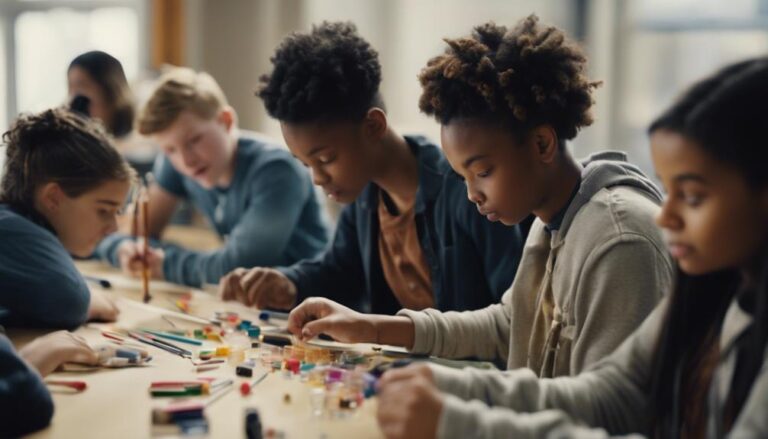Live Vs. Group Tutoring
When choosing between live and group tutoring, live sessions offer real-time interaction for personalised feedback and immediate guidance. Group tutoring provides collaborative learning with diverse perspectives and interaction. Each method caters to unique educational needs and preferences, enhancing the learning experience. Want to discover more insightful benefits and comparisons between these tutoring styles?
Advantages and Disadvantages of Live Tutoring
Live tutoring's real-time interaction with the tutor provides immediate clarification and feedback, enhancing the learning experience for students. This personalised approach allows for individualised feedback tailored to address specific challenges and learning needs. The guarantee of the support ensures that students can clarify doubts and receive guidance in real-time, leading to a more effective learning process. Customised learning is a key advantage of live tutoring, as it enables the tutor to adapt teaching strategies according to the student's pace and comprehension level. This tailored approach enhances student engagement and comprehension, making the learning experience more productive and meaningful.
Moreover, live tutoring sessions create a dynamic environment where students can actively participate, ask questions, and engage in discussions with the tutor. This interactive nature fosters deeper understanding and retention of the material. By focusing solely on the student's individual challenges and areas for improvement, live tutoring can address specific learning gaps and provide targeted support for academic growth.
Benefits of Group Tutoring
Group tutoring offers a platform for collaborative learning, allowing you to benefit from diverse perspectives and shared knowledge. Enhanced peer interaction in group settings can deepen your understanding of complex concepts through discussions and peer-to-peer explanations.
Research indicates that this interactive approach can lead to significant academic progress and improved learning outcomes for participants.
Advantages of Collaborative Learning
In small group settings for tutoring, collaborative learning offers numerous advantages that foster motivation, creativity, peer support, and self-esteem among students. Enhanced participation is a key benefit as students are more motivated and engaged when working together compared to individual study.
Shared learning experiences in group settings allow for the exchange of diverse ideas and perspectives, enhancing creativity and problem-solving skills. Peer collaboration plays an essential role in supporting students, boosting their confidence, helping them overcome shyness, and fostering the development of leadership skills.
Additionally, the group environment boosts self-esteem, leading to higher satisfaction with the learning process and increased retention of knowledge. Collaborative learning is particularly efficient and beneficial in language education, improving students' overall attitude towards the subject matter.
Improved Peer Interaction
Enhancing peer interaction through group tutoring settings cultivates a collaborative environment that nurtures teamwork and facilitates shared learning experiences among students.
Peer collaboration in group tutoring not only encourages teamwork but also sparks creativity and diverse idea generation through lively discussions.
Students supporting each other in these settings helps build confidence, develop leadership skills, and enhance overall satisfaction with the learning process.
The benefits of peer interaction extend to promoting a positive attitude towards the subject being studied. Particularly in language education, small group classes in tutoring have shown to be highly effective, emphasizing the advantages of social learning and interaction.
Embracing peer support and team learning in group tutoring enhances the educational experience for all involved.
Comparison of Interactive Learning Environments
When comparing interactive learning environments in live tutoring versus group tutoring, it's important to take into account:
- Engagement levels
- Classroom dynamics
- The advantages of student collaboration
Understanding how these factors vary between the two settings can offer valuable insights into the effectiveness of each approach.
Levels of engagement compared
Comparing engagement levels between live and group tutoring reveals distinct advantages in fostering interactive learning environments that have a notable impact on student participation and comprehension.
Live tutoring excels in student engagement by offering real-time interactions with tutors, enabling immediate feedback and clarification. This direct interaction enhances understanding and retention of information.
On the other hand, group tutoring leverages peer collaboration and friendly competition to promote engagement. Active engagement and discussions among peers in group settings create a dynamic learning atmosphere, encouraging participation and deeper comprehension.
Both tutoring methods contribute to interactive learning environments, but live tutoring's immediate feedback and interactive sessions seem to provide a more engaging experience for students, leading to enhanced learning outcomes.
Classroom Dynamics Analysis
Analysing classroom dynamics in live and group tutoring settings reveals distinct differences in interactive learning environments that have a notable impact on student engagement and participation levels. When comparing live tutoring to group tutoring, the following observations can be made:
- Real-time feedback in live tutoring enhances learning efficiency.
- Group dynamics in live tutoring settings promote collaboration and peer learning.
- Active participation is encouraged in live tutoring, fostering communication skills.
- The dynamic atmosphere created by group activities in live tutoring sessions boosts student motivation and interest in the subject.
These factors highlight the benefits of real-time feedback and group dynamics in live tutoring sessions, emphasising the importance of interactive learning environments for student engagement and academic success.
Benefits of Student Collaboration
Student collaboration in group tutoring environments enhances problem-solving skills and critical thinking abilities through fostering diverse perspectives and ideas. By working together, students can tackle complex problems, share different approaches, and learn from one another's strengths. This collaborative approach not only improves academic performance but also nurtures essential teamwork advantages and collaborative problem-solving skills. In a group tutoring setting, students engage in interactive learning experiences that promote socialisation, communication, and peer teaching. Through shared explanations and discussions, individuals deepen their understanding of concepts and develop a supportive learning community. These collaborative activities prepare students for real-world scenarios requiring collaboration, negotiation, and cooperation, making group tutoring a valuable tool for holistic skill development.
| Teamwork Advantages | Collaborative Problem Solving |
|---|---|
| Enhanced communication | Diverse perspectives |
| Peer teaching opportunities | Shared problem-solving strategies |
| Improved social skills | Critical thinking enhancement |
| Active engagement | Encouragement of creativity |
Personalised Attention Vs. Peer Learning
When looking for tutoring options, the decision between receiving individualised attention and learning from peers is a key factor in maximising academic support. Here's a breakdown to assist you in making an informed decision:
- Personal Progress: Individualised attention in one-to-one tutoring ensures bespoke learning plans tailored to individual requirements and pace, resulting in significant academic progress.
- Collaborative Atmosphere: Peer learning in group tutoring encourages collaboration, friendly competition, and improved comprehension among students, fostering socialisation and teamwork skills.
- Bespoke Strategies: One-to-one tutoring provides targeted support, enabling immediate clarification of misunderstandings and customised learning strategies to efficiently address specific needs.
- Improved Communication: Group tutoring promotes communication skills through peer interactions, creating a dynamic learning environment that enhances the overall academic experience.
Taking these factors into consideration, individualised attention is effective in meeting individual learning needs, while peer learning excels in encouraging collaboration and communication skills through group dynamics. The decision ultimately hinges on your preferences and learning objectives.
Tailored Lessons and Group Dynamics
Tailoring lessons to accommodate diverse student needs while leveraging group dynamics is a key strategy in optimising the effectiveness of group tutoring sessions. In group tutoring, individualised support is provided through lessons that cater to the specific requirements of multiple students simultaneously. This approach guarantees that each student receives personalised attention within the group setting, addressing their unique learning styles and preferences.
Additionally, social connections fostered by group dynamics play an essential role in enhancing the overall learning experience. Through social interaction, collaboration, and peer learning, students not only benefit from the expertise of the tutor but also from the diverse perspectives and insights of their peers. The dynamics of a group setting create a supportive environment where students can engage with one another, exchange ideas, and collectively work towards academic goals.
Factors Influencing Tutoring Decision
When deciding on the best tutoring option for your needs, it's important to consider factors such as individualised attention, cost-effectiveness, peer support, educator quality, and available programmes. Here are some factors to think about:
- Individualised Attention: One-to-one tutoring offers personalised lessons and rapid progress due to the focused attention from the educator.
- Cost-Effectiveness: Small-group tutoring provides affordable options with discounts ranging from 20-50% compared to individual tutoring sessions.
- Peer Support: Group dynamics in small-group tutoring enhance peer motivation, creating a supportive learning environment that encourages collaboration and engagement.
- Educator Quality: Focus on the quality of educators and their training to ensure effective tutoring sessions that meet your learning goals.
When considering tutoring options, take these factors into account to make an informed decision that aligns with your educational objectives and preferences.
Chariot Learning's expansion of small-group tutoring options demonstrates a commitment to offering diverse and effective tutoring programmes to suit various learning styles.

Benjamin Margate is a British biology author, educator and podcaster, leveraging a leveraging a BSc in Biological Sciences from University of Birmingham and over 10 years of expertise creating and curating detailed biology content. His work focuses on providing educational blogs and resources for biology students and facilitating connections with professional tutors. Recognised for his extensive knowledge and commitment to biology education, Benjamin’s contributions have become a cornerstone for learners seeking to enhance their understanding of the subject.





